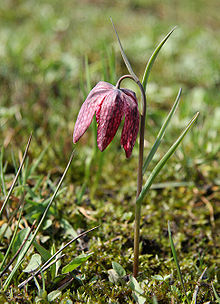- Fritillaria meleagris
-
Snake's Head Fritillary 
Fritillaria meleagris (Snake's Head Fritillary) Scientific classification Kingdom: Plantae (unranked): Angiosperms (unranked): Monocots Order: Liliales Family: Liliaceae Genus: Fritillaria Species: F. meleagris Binomial name Fritillaria meleagris
L.Fritillaria meleagris is a fritillary in the family Liliaceae. Its common names include Snake's Head Fritillary, Snake's Head (the original English name), Checkered Daffodil, Chess Flower, Frog-cup, Guinea-hen Flower, Leper Lily (because its shape resembled the bell once carried by lepers), Frog-cup, Lazarus bell or, in northern Europe, simply Fritillary.
Contents
Etymology
The name meleagris means ‘spotted like a guinea fowl’.[1]
Description and habitat
The flower has a chequered pattern in shades of purple, or is sometimes pure white.[1] It flowers from March to May and grows between 15 and 40 cm in height. The plant has a round bulb, about 2 cm in diameter which contains poisonous alkaloids. It is commonly found growing in grasslands in damp soils and river meadows and can be found at altitudes up to 800 metres.
Distribution
The Snake's Head Fritillary is native to Europe but in many places (including France, Slovenia and Romania) it is an endangered species that is rarely found in the wild but is commonly grown in gardens. In Croatia, the flower is known as kockavica and is associated by some with the country's national symbol.[2] It is the official flower of the Swedish province of Uppland, where it grows in large quantities every spring at the meadows in Kungsängen, just outside Uppsala, which gives the flower its Swedish name, kungsängslilja. It is also found in Sandemar strandängar (Sandemar beach meadows), a nature reserve west of the village of Dalarö in the Stockholm archipelago.
United Kingdom
In the United Kingdom there is some disagreement amongst botanists as to whether the Snake's Head is a native species or a long-established garden escapee. The plant was first described in the 16th century by herbalist John Gerard who had only known of it as a garden plant and it was not recorded in the wild until 1736, which has led some to argue that that it must be an escapee.[3] However, the fact that its habitat is usually confined to ancient hay meadows and it does not easily spread to adjoining land, leads others to the conclusion that it is a native species which became isolated from the European population when Britain was cut off from mainland Europe after the last glacial period.[3] The plant was once abundant in the UK, particularly in the Thames Valley and parts of Wiltshire, and was collected in vast quantities to be sold as a cut flower in the markets of London, Oxford and Birmingham. During World War II most of the ancient meadows were ploughed up and turned over to the production of food crops, destroying much of the Snake's Head's habitat.[3] Although it is still a popular garden plant it is now rare in the wild, although there are some notable sites where it is still found, such as the meadows at Magdelen College, Oxford and the Oxfordshire village of Ducklington,[3] which holds a "Fritillary Sunday" festival[4] It is also found in the North Meadow National Nature Reserve, Wiltshire and the Mickfield Meadow nature reserve in Suffolk.[5] In 2002 it was chosen as the County flower of Oxfordshire following a poll by the wild flora conservation charity Plantlife.[6]
Cultivation
Now easily available as an ornamental spring bulb for the garden, it is commonly sold as a mixture of different coloured cultivars.
-
Close up of the Snakeshead Fritillary (Taken at Magdalen College, Oxford)
Notes and references
- ^ a b Anon. "Gardens:Rosemoor:Fritillaria meleagris". Royal Horticultural Society website:. Royal Horticultural Society. http://www.rhs.org.uk/Gardens/Rosemoor/About-Rosemoor/Plant-of-the-month/April/Fritillaria-meleagris. Retrieved 29 April 2011.
- ^ Petrovčić G. (2006-05-20). "Ugrožena kockavica, nacionalni simbol Hrvatske [Kockavica, the national symbol of Croatia, is endangered]" (in Croatian). Vjesnik. http://www.vjesnik.com/html/2006/05/20/Clanak.asp?r=tem&c=4. Retrieved 2011-02-08.
- ^ a b c d Mabey, Richard; Produced by Susan Marling (Broadcast 10 July 2011). "Snake's Head Fritillary". Mabey in the Wild. Just So radio production for BBC Radio4. http://www.bbc.co.uk/programmes/b012f7mn. Retrieved 29 July 2011.
- ^ Onon. "Fritillary Sunday". St Bartholomew's Church. St Bartholomew's Church. http://www.ducklingtonchurch.org.uk/events/fritillary/. Retrieved 29 July 2011.
- ^ Anon. "Mickfield Meadow". Suffolk Wildlife Trust. Suffolk Wildlife Trust. http://www.suffolkwildlifetrust.org/reserves-and-visitor-centres/mickfield-meadow/. Retrieved 29 July 2011.
- ^ Plantlife website County Flowers page
External links
Categories:- Fritillaria
- Flowers
- Flora of Croatia
Wikimedia Foundation. 2010.




